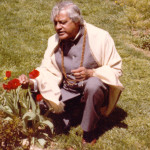The workings of the mind when interpreting existence
That just shows how the mind works. When you say you are coming and you don’t come how truthful are you to yourself. There we go. Sensory input is governed by the manas or the lower mind which receives the senses of seeing, hearing, smelling, touching and tasting. But in the reception in the lower mind it cannot exist by itself for the lower mind has to travel down to chitta, which is your subconscious mind or memory box. Now, in this memory box are stored all the memories since you have been created or been brought into existence from that sub, sub, sub, atomic matter which even goes beyond the quarks that science are talking about today; it is still even finer. And in deep meditation when you reach the superconscious state, the superconscious level, you can go to the subtlest of the subtlest matter from which you have evolved through mineral, plant, animal and to this stage. Now, according to some theologies it took you eight hundred and forty million years to reach this stage. Therefore the human stage is regarded to be the most valuable stage in this complexity of this world we live in. So you can be damned glad.
Now, so the lower mind, or the manas, is the recipient of the sensory input. You experience through the lower mind only that which you could see, which you could hear, which you could smell, which you could touch, which you could taste. That is all what the lower mind can see or observe or experience. But then that experience of these five has to be verified by transmitting itself to the memory box, which contains all memories, to repeat again, and that is nothing else but your subconscious mind. Right. Now, your subconscious mind let us compare it to a vast filing cabinet where you pull out files continuously. So if you see a cat you will not recognize the cat unless you have not known of a cat before in your subconscious mind; or a dog, or a cow, or a bull, or whatever. So the lower mind is totally dependent on the subconscious mind, or the memory box, to give you any recognition in the conscious mind.
Now, let me tell you this that although we are drawing sections there they do not operate sectionally they operate in oneness. But for the purpose of illustration we are just making sections there.
Now, after the cognition comes to the lower mind from the subconscious mind, chitta, it still has to go further. It goes to the I self, or the ego self, which in turn is controlled by the buddhi self, because the intellect determines the value of the impressions gained in the lower mind. And then the intellect with the condition of the ego will determine if seeing, hearing, smelling, touching, tasting is valid or not. And you might eat, for example, the same food three nights in a row and every day you will find the same food tasting differently. Why? Because the subconscious self has gathered various experiences of taste. So here the tastes merge. And when you do not like the taste of the chicken that you have eaten the night before, as leftovers, okay, fine, then remember you are pulling out another facet from that subconscious mind of the chicken. And therefore the conflict begins of liking or disliking. Can you see? Okay. Of liking or disliking.








Speak Your Mind